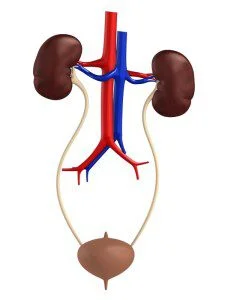Pyeloplasty
 What is Pyeloplasty?
What is Pyeloplasty?
Pyeloplasty is a surgical procedure to remove a blockage in the ureter (the tube that carries urine from the kidney to the bladder) due to a narrowing of the tube where it attaches to the kidney. After the blockage is removed, the ureter is reconnected to the kidney and a stent is placed to allow healing and drainage of urine from the kidney.
This type of blockage is called ureteropelvic junction obstruction (UPJ obstruction). In UPJ obstruction, urine is unable to pass from the kidney into the ureter, resulting in both urine and pressure build up inside the renal pelvis and kidney- causing pain, kidney stones, and potentially the decline in the kidney’s function over time
Causes
While UPJ obstruction is a relatively common problem seen in children, it can also develop in adults. In most cases, patients are born with the predisposition to UPJ obstruction. However, it can also develop over time due to trauma, body growth, scar tissue, ureteral kinks or valves or a crossing blood vessel.
In nearly 50 percent of the adult cases, the obstruction is caused by an extra blood vessel, usually and artery that supplies the lower part of the kidney. As the individual ages, the vessel gets bigger. Since the blood vessel will typically lie over the ureter, it can cause obstruction. This is called a “crossing vessel.”
Symptoms of UPJ Obstruction
There may not be any symptoms. When symptoms occur, they may include
- Back or flank pain
- Bloody urine (hematuria)
- Lump in the abdomen (abdominal mass)
- Kidney infection
- Urinary tract infection, usually with fever
- Vomiting
Open vs. Laparoscopic Surgery
The traditional treatment for UPJ obstruction was open pyeloplasty. In recent years, however, laparoscopic pyeloplasty has developed as an attractive alternative. In laparoscopic pyeloplasty, the doctor uses special tools and small incisions.
Advantages of laparoscopic pyeloplasty over the conventional open surgical technique include:
- Significantly less post-operative pain
- A shorter hospital stay
- Earlier return to work and daily activities
- More favorable cosmetic results
- The same high success rate as the open procedure
da Vinci
Surgeons can perform pyeloplasty surgery using da Vinci technology. With a da Vinci system, your surgeon sits at a console next to your child or you and operates using tiny, fully wristed instruments.
A camera provides a high-definition, 3D magnified view inside the body. The da Vinci system translates every hand movement your surgeon makes in real time to bend and rotate the instruments with precision.
There are two minimally invasive pyeloplasty options: laparoscopic surgery and robotic-assisted surgery (possibly with da Vinci technology). Both are performed through a few small incisions. To perform a laparoscopic pyeloplasty, surgeons use special long-handled tools while viewing magnified images from the laparoscope (camera) on a video screen.
Overall Recovery
It will take 10-14 days to recover fully from the procedure and most people can return to normal activities after 2-4 weeks. You may find that the ureteric stent, the lower end of which sits in the bladder, causes some pain when you pass urine and you may also see blood in the urine as a result of the stent.


 What is Pyeloplasty?
What is Pyeloplasty?